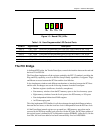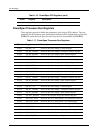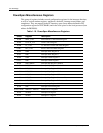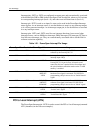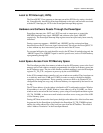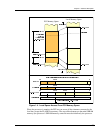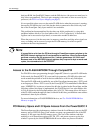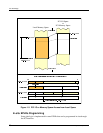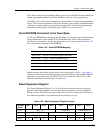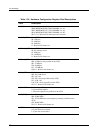
Chapter 1: Hardware Description
4538 Hardware Reference Manual 21
Local to PCI Interrupt (–INTA)
The PowerQUICC II can generate an interrupt toward the PCI Host by setting a doorbell
bit. Conventionally, doorbell bit 0 has been dedicated to this task, and has been associated
with the PCI interrupt pin –INTA in the PowerSpan Interrupt Map registers.
Hardware and Software Resets Through the PowerSpan
PowerSpan interrupt pins –INT2 and –INT3 are used as output ports to control the
MPC8260 hardware reset signal –HRESET and software reset signal –SRESET
respectively. The PowerSpan Interrupt Map registers must have previously been correctly
initialized.
During a power-up sequence, –HRESET and –SRESET are first activated and then
deactivated once the PCI bus reset signal is deactivated. This allows the PowerQUICC II
to boot without any host intervention, just after the end of the PCI reset.
For a normal utilization, the card should be reset by the PCI host (if needed) using only the
–SRESET signal. The –HRESET signal is used for special cases, such as FLASH memory
reprogramming through PCI.
Local Space Access From PCI Memory Space
The PowerSpan provides four memory windows from the PCI memory space to the Local
memory space. Each window can map a programmable size of the local memory space into
the PCI memory space. The size of the windows and their enabling is set in the PowerSpan
registers P1_TIx_CTL, and preset at power-up by the serial EEPROM.
In the 4538 communications controller, only two windows are enabled. They have been set
to a relatively small size (2 MB and 512 KB), in order to comply with high availability
operating system requirements. These operating systems are able to do dynamic PCI re-
configuration during hot swap, only if the total memory size requested by the board is not
too big.
The PCI base address of each window is defined in a PCI configuration register. Window
0 base address is set in P1_BAR2, Window 1 base address is set in P1_BAR3, etc. Each
window can be moved on the local memory space, using a PowerSpan translation register
(P1_TIx_TADDR), so that even a small window can allow access to any part of the 4 GB
of local memory space.
During a PCI host access to the local space, the high-order address bits of the local bus must
be generated by the PowerSpan (as defined in the PowerSpan P1_TI0_TADDR register)
and the low-order address bits of the local bus come from the PCI address. This mode is
called “Address Translation” in the PowerSpan Manual.



